
ATC
System and Message Overviews
Document Version: 6.2
Date: May 26, 2015
Document Revision History
The following revision history table reflects all substantive changes to this document.
| Date | Description of Updates Made |
16-March-09 |
No major changes to this document. See individual message change tables for technical details on changes to those messages. |
| 01-October-09 | Updates to AT001, AT002, and AT003. |
| 18-November-09 | Updates to AT001, AT002, and AT003. |
| 31-July-10 | Updated AT001, AT002, and AT003 from DRAFT to version 1. |
| 30-August-10 | Updated links for new Bookshelf directory structure. |
| 7-October-10 | Updates to AT002. |
| 15-November-11 | New XSD. Added new messages AT011, AT012, AT013, AT014, AT015, AT016. |
| 17-February-12 | New XSD. Updated message AT002, AT011, AT012. |
| 15-November-11 | New XSD. Added new messages AT011, AT012, AT013, AT014, AT015, AT016. |
| 6-May-12 | New XSD. Updated message AT011, AT012, AT013, AT014, AT015, AT016. New AT018. |
| 15-August-12 | New XSD. Updated message AT011, AT012, AT015, AT016, AT018. |
| 15-November-12 | New XSD. Updated message AT011, AT012, AT016, AT018. |
| 26-February-13 | New XSD. Updated message AT011, AT012, AT013, AT014, AT015, AT016, AT018. LatVersion2Type - changed annotations of hemisphere from E=East, W=West to N=North, S=South. xsd change of annotations only…no sample, or other impacts are caused by this change. |
| 23-July-13 | New XSD. Updated message AT011; The "action" element in the AT011 updated the default of "File Now with All Addresses." - CustomerID is corrected to a pattern of "[A-Z0-9]{0,8} *", AT012; modified the "owner" field in the AOC message header to carry an identifier so that an AT012 Publish msg is routed back to the correct originator., AT013, AT014, AT015, AT016, AT018. AT011, 12, 13, 14, 15, 18 changes ATC.xsd - AircraftId code now required, not optional; change initialLevel to 3min/4max integer. |
| 8-November-13 | New XSD. New AT011 through AT018 V2 (V1 deprecated). |
| 19-March-14 | New XSD. AT011, and AT018: Added new element to account for filing strip in Field 19, based on customer preferences. " field19PrefDashOn, boolean, Are client preferences for Field 19 set to show filing strip info in Field 19? If yes, then set to "1" or "true". The filing strip info will be included in Field 19. If no, then set to "0" or "false" and the filing strip info will be included in Field 18 . Required boolean, non-nillable. " Modified xsd EET to support 9 characters instead of 8. Element name "eetsToLocations", repeatable from 1…50. Updated filingCenter to optionally allow non-US flights to be filed without the filingCenter. |
| 18-September-14 | Updated flightPlanHeader/originator. Made originator optional. Affects all ATC.xsd messages. |
| 26-May-15 | New XSD. Common.xsd added flightKey which had a trickle-down effect causing this xsd to be updated |
Table Of Contents
1 Introduction
This document defines the interfaces which govern the interchange of data between an Air Traffic Control (ATC) system and other systems within an Airline Operation Center (AOC). Each AOC interface is represented by a message described in an associated XSD (XML Schema Definition). The XSD defines and enforces the required, optional, and conditional data that can be included in a message.
1.1 Audience
The intended audience for this document includes existing and potential Jeppesen customers, integration partners, and personnel with roles associated with application architecture, application development, system testing, implementation, and application support within ATC.
1.2 Scope
This document discusses the ATC messages currently supported by the Jeppesen Solution Integrator. Each message description includes the following:
- Overview for common message uses within an AOC
- Message Version Summary listing all available versions of each message
- Links to the message specifications including direct links to XSD documentation, where you can explore the XSD hierarchy and interface specifications in a navigable HTML format
- Links to the XSD source code
- Links to sample XML messages for each AOC message
Other data interfaces or formats not included in this document will be considered custom and not supported.
1.3 XML Schema/XSD
The XML schema for this ICD is published in the following file: ATC.XSD
2 Message Summary
Table 2-1 lists the messages that can be sent or handled by the application. The messages originated by this application (messages that begin with “AT”) are further discussed in Section 3 AOC Interface Messages.
Table 2-1 Message Summary
| ID | Message |
Publish |
Subscribe |
Request |
Response |
AT001 |
File Flight Plan Strip (Legacy Filing Service) |
X |
|
|
|
AT002 |
Acknowledge Filed Flight Plan (Filing strip)(Legacy Filing Service) |
X |
|
|
|
AT003 |
Cancel Filed Flight Plan (Filing strip)(Legacy Filing Service) |
X |
|
|
|
AT011 |
File Flight Plan (ICAO 2012 format) |
X |
|
|
|
AT012 |
Acknowledge Flight Plan (ICAO 2012 format) |
X |
|
|
|
AT013 |
Cancel Flight Plan (ICAO 2012 format) |
X |
|
|
|
AT014 |
Delay Filed Flight Plan (ICAO 2012 format) |
X |
|
|
|
AT015 |
Flight Plan Status (ICAO 2012 format) |
|
|
X |
X |
AT016 |
Flight Plan History (ICAO 2012 format) |
|
|
X |
X |
AT018 |
Filing Strip (ICAO 2012 format) |
|
|
X |
X |
3 AOC Interface Messages
The following messages are processed by the ATC system.
3.1 AT001 - File Flight Plan Strip (Legacy Filing Service)
3.1.1 Message Overview
This message is used for filing a flight plan with the ATC. This message supports domestic and International rules and the ability to file ICAO and FAA flight plans.
3.1.2 Message System Flow
This message interacts with the systems as shown in Figure 1.
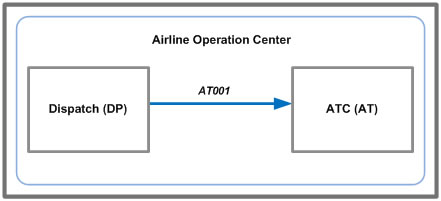
Figure 1. AT001 message system flow
3.1.3 Message Details
The following table provides details on the message version and includes links to the message’s technical specification.
Message Version |
AT001 v1 |
Message Header Details |
msgName: AT001 |
Message Specification |
|
Defined in XSD |
|
Sample Messages |
|
| Message Version History | Original publication of message version 1. |
3.2 AT002 – Acknowledge Filed Flight Plan (Filing Strip)(Legacy Filing Service)
3.2.1 Message Overview
This message is used to provide an acknowledgement of a filed flight plan. This message can be used to provide an acknowledgement by the ATC of acceptance or a rejection of the flight plan.
3.2.2 Message System Flow
This message interacts with the systems as shown in Figure 2.
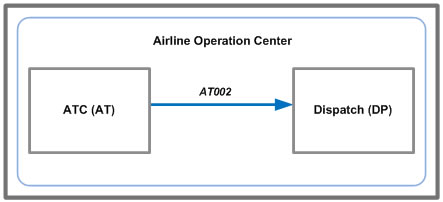
Figure 2. AT002 message system flow
3.2.3 Message Details
The following table provides details on the message and includes links to the message’s technical specification.
Message Version |
AT002 v1 |
Message Header Details |
msgName: AT002 |
Message Specification |
|
Defined in XSD |
|
Sample Messages |
|
| Message Version History | Updated message. |
3.3 AT003 – Cancel Filed Flight Plan (Filing Strip)(Legacy Filing Service)
3.3.1 Message Overview
This message is used to cancel a filed flight plan.
3.3.2 Message System Flow
This message interacts with the systems as shown in Figure 3.
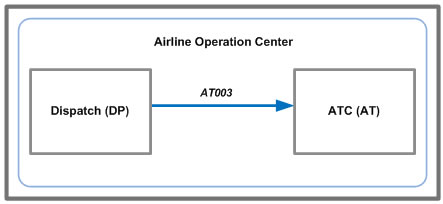
Figure 3. AT003 message system flow
3.3.3 Message Details
The following table provides details on the message and includes links to the message’s technical specification.
Message Version |
AT003 v1 |
Message Header Details |
msgName: AT003 |
Message Specification |
|
Defined in XSD |
|
Sample Messages |
|
| Message Version History | Original publication of message version 1. |
3.4 AT011 – File Flight Plan (ICAO 2012 format)
3.4.1 Message Overview
The AT011 File Flight Plan message is used by a client to submit a flight plan filing or flight plan change request to ATC through Flight Plan Filing Service. Upon response from ATC, the Flight Plan Filing Service sends acknowledgement of the filing/change request to the client using the AT012 Acknowledge Flight Plan message.
In order to successfully process a flight plan filing/change request with ATC, it is required that the following information is specified in the AT011 File Flight Plan request message:
| * Flight key consisting of: | |||
- Flight number |
|||
- Airline code |
|||
- Flight origin date |
|||
- POD |
|||
| * Message type | |||
| * Estimated departure time | |||
| * POD | |||
| * POA | |||
| * Aircraft registration mark | |||
| * Aircraft equipment code | |||
| * Total estimated elapsed time | |||
| * Estimated elapsed time at locations | |||
| * Wake turbulence category | |||
| * Flight category | |||
| * Flight rules | |||
| * EOBT | |||
| * Filing center | |||
| * Route definition | |||
Each element in the AT011 File Flight Plan message represents an important part of the overall structure of a flight plan filing/change. Most of these elements directly correlate to one or more fields on form FAA 7233-4 (ICAO FPL) and form FAA 7233-1 (NAS FP).
3.4.2 Message System Flow
This message interacts with the systems as shown in Figure 4.

Figure 4. AT011 message system flow
3.4.3 Message Details
The following table provides details on the message and includes links to the message's technical specification.
Message Version |
AT011 v2 |
Message Header Details |
msgName: AT011 |
Message Specification |
|
Defined in XSD |
|
Sample Messages |
Samples not yet available for this message version. |
| Message Version History | Version 1: |
3.5 AT012 – Acknowledge Flight Plan (ICAO 2012 format)
3.5.1 Message Overview
The AT012 Acknowledgement Flight Plan message is used by the Flight Plan Filing Service to communicate information to a client in response to an action taken by the Flight Plan Filing Service, an ATC response, or a problem with a filing request. Acknowledgement may include the following: ATC RESPONSE, MISSING VALUE, XMIT ERROR, FAIL, QUEUED, FILED, ACCEPTED, REJECTED, PENDING, AMENDED, DELAYED, CANCELLED, CHANGE REQUESTED, CHANGE ACCEPTED, CHANGE REJECTED, CHANGE PENDING, CHANGE AMENDED, FLIGHT SUSPENDED, FLIGHT DE-SUSPENDED, or CONVERTED TO CHG.- FPFS example: Missing Value, XMIT Error, Fail
- ATC example: FLIGHT SUSPENDED (FLS), FLIGHT DESUSPENDED (DES)
- Response to status request example: FILED, ACCEPTED, REJECTED, PENDING, AMENDED, DELAYED, SUSPENDED, CANCELLED, CHANGE REQUESTED, etc.
- Response to history request example: FLIGHT PLAN HISTORY
Upon response from ATC, the Flight Plan Filing Service logs the transaction, and sends acknowledgement of the filing/change request to the client using the AT012 Acknowledge Flight Plan message. The transaction is maintained in a log indefinitely or until it is manually removed.
3.5.2 Message System Flow
This message interacts with the systems as shown in Figure 5.

Figure 5. AT012 message system flow
3.5.3 Message Details
The following table provides details on the message and includes links to the message's technical specification.
Message Version |
AT012 v2 |
Message Header Details |
msgName: AT012 |
Message Specification |
|
Defined in XSD |
|
Sample Messages |
Samples not yet available for this message version. |
| Message Version History |
Version 1: |
3.6 AT013 – Cancel Flight Plan (ICAO 2012 format)
3.6.1 Message Overview
The AT013 Cancel Flight Plan message is used to submit an ICAO 2012 formatted filed flight plan cancellation request to ATC through the Flight Plan Filing Service. Upon response from ATC, the Flight Plan Filing Service sends an acknowledgement of the cancellation request to the client using the AT012 Acknowledge Flight Plan message.
In order to successfully process a flight plan cancellation request with ATC, it is required that the following information is specified in the AT013 Cancel Flight Plan request message:
| * Flight key consisting of: | |||
- Flight number |
|||
- Airline code |
|||
- Flight origin date |
|||
- POD |
|||
| * Message type | |||
| * Estimated departure time | |||
| * POD | |||
| * POA | |||
| * Aircraft registration mark | |||
When the Flight Plan Filing Service receives a cancelation request, it "looks" for the matching stored filing request to see if it has been submitted to ATC or queued for delivery. The following occurs depending on what is determined:
- If the Flight Plan Filing Service is unable to find a filing request whose key fields match the values in the AT013 Cancel Flight Plan request, the Flight Plan Filing Service sends an error to the client using the AT012 Acknowledge Flight Plan message, and assigns the "FAIL" status to the request.
- If the Flight Plan Filing Service finds a matching filing whose status is "REJECTED" or "CANCELLED", it sends an error to the client using AT012. it sends an error to the client using AT012 with the status "FAIL".
- If the Flight Plan Filing Service finds a filing request submitted to ATC whose key fields match the values in the AT013 Cancel Flight Plan request, it looks up the filing address(es) for the request and sends notice of the filing cancelation to ATC. The Flight Plan Filing Service assigns the "CANCELLATION SUBMITTED" status to the stored flight plan. An acknowledgement is not sent back to the client.
- If the Flight Plan Filing Service finds a filing request whose key fields match the values in the AT013 Cancel Flight Plan request that is queued for delivery to ATC, it removes the filing from the queue and assign the "CANCELLED" status to the stored flight plan status. An acknowledgement is not sent back to the client.
The transaction is kept in the transaction log indefinitely or until it is manually removed.
The Flight Plan Filing Service logs messages from ATC in response to a CNL request.
The Flight Plan Filing Service logs the transaction when it removes a queued filing request from the queue. The transaction is kept in the transaction log indefinitely or until it is manually removed.
The Flight Plan Filing Service stores the estimated off block time for a filing request. When the Flight Plan Filing Service receives a CNL request for an ICAO filing, it retrieves the estimated off block time for the stored flight plan and sends it in a CNL request to ATC using the DOF/ indicator in field 18. If the Flight Plan Filing Service is unable to retrieve the estimated off block time for the stored flight plan, it sends an error to the client instead of sending the request using DLA/-0.
3.6.2 Message System Flow
This message interacts with the systems as shown in Figure 6.

Figure 6. AT013 message system flow
3.6.3 Message Details
The following table provides details on the message and includes links to the message's technical specification.
Message Version |
AT013 v2 |
Message Header Details |
msgName: AT013 |
Message Specification |
|
Defined in XSD |
|
Sample Messages |
Samples not yet available for this message version. |
| Message Version History |
Version 1:
* Upgraded message to production version 1 Version 2: * New version 2, version 1 deprecated |
3.7 AT014 – Delay Filed Flight Plan (ICAO 2012 format)
3.7.1 Message Overview
The AT014 Delay Flight Plan message is used to submit a flight plan delay request to ATC through the Flight Plan Filing Service. Upon response from ATC, the Flight Plan Filing Service sends acknowledgement of the delay request to the client using the AT012 Acknowledge Flight Plan message.
In order to successfully process a flight plan delay request with ATC, it is required that the following information is specified in the AT013 Cancel Flight Plan request message:
| * Flight key consisting of: | |||
- Flight number |
|||
- Airline code |
|||
- Flight origin date |
|||
- POD |
|||
| * Revised departure time | |||
| * Message type | |||
| * Estimated departure time | |||
| * POD | |||
| * POA | |||
| * Aircraft ID code | |||
When an AT014 Delay Flight Plan request is sent, the Flight Plan Filing service "looks" for a matching stored filing request to see if it has been submitted to ATC or queued for delivery. The following occurs depending on what is determined:
- If the Flight Plan Filing Service is unable to find a filing request whose key fields match the values in the AT014 Delay Flight Plan request, the Flight Plan Filing Service sends an error to the client using the AT012 Acknowledge Flight Plan message, and assign the FAIL status to the request.
- If the Flight Plan Filing Service finds the delay request does not have a revised ETD, the Flight Plan Filing Service sends an error to the client using AT012 with the status "MISSING VALUE".
- If the Flight Plan Filing Service finds a matching filing whose status is "REJECTED" or "CANCELLED", it sends an error to the client using AT012 with the status "FAIL".
- If the Flight Plan Filing Service finds a filing request submitted to ATC whose key fields match the values in the AT014 Delay Flight Plan request, it looks up the filing address(es) for the request and sends a notice of the filing delay to ATC, and assigns the "DELAYED" status to the stored flight plan. An acknowledgement is not sent back to the client.
- If the Flight Plan Filing Service finds a matching filing whose key fields match the values in the AT014 Delay Flight Plan request and that is queued for delivery to ATC, it updates the ETD/EOBT in the flight plan. An acknowledgement is not sent back to the client.
- If the ETD in a AT014 Delay Filed Flight Plan message request causes the date of flight to occur the next day, the AT014 will be converted to a AT011 File Flight Plan message and the message request will be filed as a change (CHG) rather than a delay.
3.7.2 Message System Flow
This message interacts with the systems as shown in Figure 7.

Figure 7. AT014 message system flow
3.7.3 Message Details
The following table provides details on the message and includes links to the message's technical specification.
Message Version |
AT014 v2 |
Message Header Details |
msgName: AT014 |
Message Specification |
|
Defined in XSD |
|
Sample Messages |
Samples not yet available for this message version. |
| Message Version History |
Version 1:
* Upgraded message to production version 1 Version 2: * New version 2, version 1 deprecated |
3.8 AT015 – Flight Plan Status (ICAO 2012 format)
3.8.1 Message Overview
The AT015 Flight Plan Status message is used by a client to submit a request to the Flight Plan Filing Service for the status of a flight plan. The Flight Plan Filing Service responds to the request with the flight plan status using the AT015 Flight Plan Status response message.
3.8.2 Message System Flow
This message interacts with the systems as shown in Figure 8.
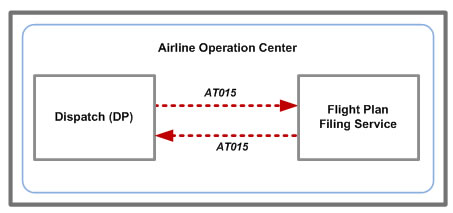
Figure 8. AT015 message system flow
3.8.3 Message Details
The following table provides details on the message and includes links to the message's technical specification.
Message Version |
AT015 v2 |
Message Header Details (REQUEST/RESPONSE) |
msgName: AT015 |
Message Specification |
AT015 FlightPlanStatusRequest(ICAO 2012 format)Type |
Defined in XSD |
|
Sample Messages |
Samples not yet available for this message version. |
| Message Version History |
Version 1: * Upgraded message to production version 1 Version 2: * New version 2, version 1 deprecated |
3.9 AT016 – Flight Plan History (ICAO 2012 format)
3.9.1 Message Overview
The AT016 Flight Plan History message is used by a client to submit a request to the Flight Plan Filing Service for historical information about a flight plan. The Flight Plan Filing Service responds to the request with the flight plan history using the AT016 Flight Plan History response message.
3.9.2 Message System Flow
This message interacts with the systems as shown in Figure 9.
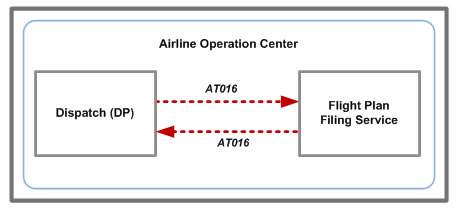
Figure 9. AT016 message system flow
3.9.3 Message Details
The following table provides details on the message and includes links to the message's technical specification.
Message Version |
AT016 v2 |
Message Header Details (REQUEST/RESPONSE) |
msgName: AT016 |
Message Specification |
AT016 FlightPlanHistoryRequest(ICAO 2012 format)Type |
Defined in XSD |
|
Sample Messages |
Samples not yet available for this message version. |
| Message Version History |
Version 1:
* Upgraded message to production version 1 Version 2: * New version 2, version 1 deprecated |
3.10 AT018 – Filing Strip (ICAO 2012 format)
3.10.1 Message Overview
The AT018 Filing Strip message is used by a client to submit a request for a filing strip to the Flight Plan Filing Service. Upon receipt of a filing strip request, The Flight Plan Filing Service creates the filing strip and sends it to the requesting client in the AT018 Filing Strip Response message.
3.10.2 Message System Flow
This message interacts with the systems as shown in Figure 10.
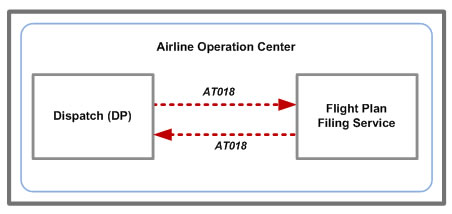
Figure 10. AT018 message system flow
3.10.3 Message Details
The following table provides details on the message and includes links to the message's technical specification.
Message Version |
AT018 v2 |
Message Header Details (REQUEST/RESPONSE) |
msgName: AT018 |
Message Specification |
AT018 FilingStripRequest(ICAO 2012 format)Type |
Defined in XSD |
|
Sample Messages |
Samples not yet available for this message version. |
| Message Version History |
Version 1:
* Upgraded message to production version 1 Version 2: * New version 2, Updated filingCenter to optionally allow non-US flights to be filed without the filingCenter. Version 1 deprecated. |